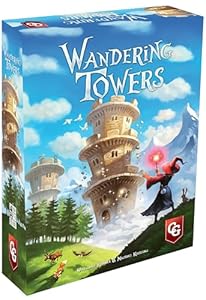Disclosure: Meeple Mountain received a free copy of this product in exchange for an honest, unbiased review. This review is not intended to be an endorsement.
If you’ve followed any of my family-weight review content over the last three years, you know my general rules regarding these products: if my kids keep asking to play the games, it’s going to get a high score.
Here’s the surprise with Wandering Towers (2022, Capstone Games): the adults who tried it loved it even more than the kids did.
When Wandering Towers arrived, my seven-year-old son wanted to try it out. Wizards on the cover, some animals running around? That was enough to bust it out. We learned the rules, then played a two-player competitive game. That went well, so we did a two-player co-op game.
Then he asked to play it again the next day and joined my review crew for a five-player game. He came in second place, then he asked to play it again the following night.
But the reviews were even stronger with the three adults in that five-player game. Two of them said they loved it, with one immediately looking online to price out a purchase. (We’ll come back to this.)

Wandering Towers has a simple concept: get your small pool of wizard meeples into Ravenskeep, a tower represented by an open-faced black tower receptacle on one of the 16 spaces of the ring-shaped board. To achieve your goal, you’ll need to move some of the game’s nine regular towers around the map, advancing your wizards in the process. The part that makes the game tricky—the towers can be stacked, temporarily burying wizards under multiple layers of a stack of tower pieces.
For an old guy like me, remembering where my wizards are buried is 75% of the game.
On a turn, players have to play two of the three cards from their hand, cards that list a specific number of spaces you must move one of your wizards or any of the game’s towers forward in a clockwise direction. So, kudos to the design: choices are very, very limited, removing most of the game’s downtime tied to “analysis paralysis.” If you move a tower forward and cover any wizard (including your own), you get to fill an empty potion bottle. Filled potions are the other half of the game’s win condition, and provide players with a chance at bonus actions randomly selected during setup.
Wandering Towers is always a race, and it’s always close. Crafty players might be able to get two wizards into Ravenskeep on the same turn, leading to some nice drama as play rounds the corner to completion. The game scales nicely to its player count and differing play formats. You can play it solo, it accommodates up to six players, and there are team variants and a co-op mode, all with a pool of eight different spells that can be cast as bonus actions, with anywhere from 2-8 of those spells included in each game.

You Need to Own Wandering Towers
Besides the fact that it is fantastic, you don’t need to know too much else about why you should pick up a copy of Wandering Towers, but I’ll add a few reasons below:
- Wandering Towers was designed by Michael Kiesling and Wolfgang Kramer, who have separately and collectively designed some of the best games ever made: Azul, El Grande, The Princes of Florence, Tikal, and Downforce, to name just a few. The accessibility and depth in their previous designs is enough to give Wandering Towers a look.
- Thanks to those wizards, Wandering Towers does have a hint of the Harry Potter world in its design. It’s easy for kids to imagine flying around at Hogwarts, dropping towers on one another before using their magic to move towers around again and again.
- Speaking of dropping towers, my son got a lot of mileage out of the line “I’m gonna crush that wizard” by covering wizards with other towers. Sometimes, he did it because he needed to fill a potion bottle. Sometimes he did it just to slow other players down. But, he always did it because he loved it.
- Wandering Towers, regardless of the player count, takes about 30 minutes to play. That’s the right amount of time for the type of game it is.
- The game’s artwork was provided by Michael Menzel, the game designer who is also the award-winning artist of games such as Dominion, Shogun, the original Rococo, and recent work such as Beer & Bread and The Adventures of Robin Hood.

Here’s the only reason Wandering Towers is not a perfect five out of five: the price. The suggested retail price is almost $50. That’s a bit too high for a family game with a decent insert/organizer, cardboard towers and a deck of 90 cards. I will get my money’s worth out of it because this is a family game that will come out a couple times a month (more if my son has anything to say about it), but full disclosure: I didn’t buy my copy of the game.
The price was a sting for that guy in my review group, the one who said that he was going to run out and buy a copy. After seeing the price, he wanted to consider other game purchases this month first.
At $30, Wandering Towers is a shove-your-neighbor-out-of-the-way no-brainer. At $40? Fair. At $50? Get Wandering Towers, but buy it for your family for the holidays. And if you can find a sale or acquire this through a math trade or other means, absolutely do that now!












